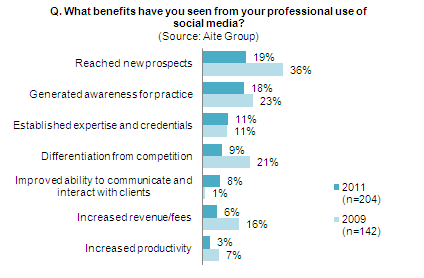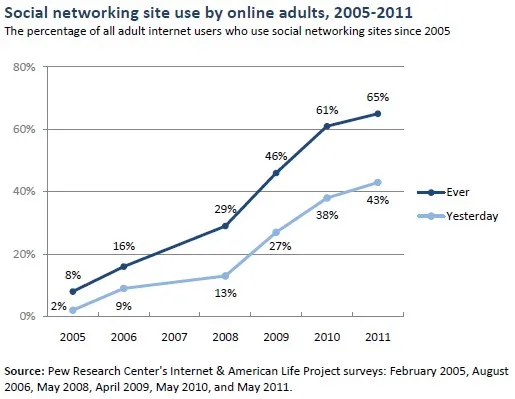Executive Summary
As social media continues to take the world by storm, advisors are increasingly under pressure to begin using social media in their own practices. Yet the advisory community has generally been slow to adopt, due both to the compliance challenges involved, and a general wariness about whether prospective clients would really make a decision to trust and work with an advisor based on social media marketing. In fact, a recent study by the Aite Group suggested that "the bloom is off the rose" when it comes to advisors adopting social media to bring in new business. Yet at the same time, a new social media trend is emerging - using social media not to develop new clients, but to better communicate and interact with existing clients. And the good news is that this approach to social media potentially has far fewer compliance headaches, too, because it's less about talking, and more about listening.
 The inspiration for today's blog post comes from a summary of results from the Aite Group's recent research on the benefits that advisors are reporting from their professional use of social media. As is evident from the chart to the right - and the Aite Group's own summary of the results - there has been a marked decrease in the benefits that advisors are reporting from their social media use - fewer prospects reached, less awareness generated, and a sharp decline in the perceived differentiation from the competition. In point of fact, this last shift - less differentiation for using social media as more advisors adopt it - may also go far to explain why advisors are reaching fewer new prospects and having more trouble generating awareness. Yet the striking part of the results to me is not just the categories that declined, but the one that saw a dramatic increase: "improved ability communicate and interact with clients."
The inspiration for today's blog post comes from a summary of results from the Aite Group's recent research on the benefits that advisors are reporting from their professional use of social media. As is evident from the chart to the right - and the Aite Group's own summary of the results - there has been a marked decrease in the benefits that advisors are reporting from their social media use - fewer prospects reached, less awareness generated, and a sharp decline in the perceived differentiation from the competition. In point of fact, this last shift - less differentiation for using social media as more advisors adopt it - may also go far to explain why advisors are reaching fewer new prospects and having more trouble generating awareness. Yet the striking part of the results to me is not just the categories that declined, but the one that saw a dramatic increase: "improved ability communicate and interact with clients."
As I noted a year ago, social media is not only a tool for developing new business; it is also a means to deepen existing client relationships, and get a better understanding of the issues and concerns that are relevant to them. In other words, instead of using social media tools to broadcast information and "talk" use it instead to hear what your clients are saying and "listen." For instance...
- Instead of using Facebook to create a fan page for your firm, create a personal account and "Friend" your existing clients. The point here is not to broadcast anything via Facebook; in fact, you don't have to write anything at all (or deal with the compliance issues associated with writing things on Facebook). Instead, the purpose is to see what your clients are posting on Facebook. When you have an upcoming meeting, you don't just look through the client's details in your CRM software to remember important conversation points; you look at their Facebook timeline, and see what's been happening in their lives lately, from the new photos of their vacation (now you know where they went and what they did) to the new additions to their family (did you see the baby pictures?). And not all of this is purely social; those pictures of the new grandchild not only means that "congratulations" is in order, but also that it may be time to open a 529 plan or to update the estate plan.
- Instead of using LinkedIn to find prospective clients, or ask your existing relationships to introduce you to prospects, just get connected to your current clients and monitor their updates on LinkedIn. You'll see everything from a job promotion to a change of employment - possibly before the client calls you to tell you about it - giving you the opportunity to then proactively reach out with an email or telephone call to wish them congratulations, and perhaps to start a conversation on a planning related issue (old 401(k) to roll over? new deferred compensation decisions to make? new employee benefits to coordinate?).
- Instead of using Twitter to broadcast news, articles, and other content to your followers, "follow" your clients on Twitter. Look at what they are communicating. See what content your clients are sharing and "retweeting" that is important to them. Watch for your clients to announce important things that are relevant to their lives, but may be relevant to your planning work as well; for instance, as I highlighted in a prior blog post, an announcement about a child starting day care can prompt a financial planning conversation by email or telephone about more time to do consulting work, adopting an individual 401(k) plan, or sending information about how the Child Tax Credit works.
This isn't to suggest that social media isn't also a valuable tool for more proactive engagement with prospective clients as well. The point is simply that while business development is a means of deriving value from social media by talking and broadcasting and engaging, using social media to just listen can still be an effective means to get better insight and connection into what's going on in the lives of your existing clients.
The upside to the listening approach to social media is that it also produces far fewer compliance headaches. For instance, connecting via Facebook or Twitter simply requires that you make a basic account so that you can "friend" or "follow" your clients; you don't have to write or post anything, which eliminates virtually all compliance-related concerns, as compliance is focused primarily on what you communicate out, not the mere fact that you have an account to listen. LinkedIn doesn't pose much of a challenge either, although it is important to turn off the Recommendations feature or regularly monitor the recommendations on your page to ensure there aren't any that might constitute a client testimonial.
 While it's true that some of your clients won't be on any social media platform, there's a good chance you'll find most of your client on at least one of them, as social media continues to expand at a rapid pace. And it's not just the younger clients, either; in 2011 alone, there was a 60% increase in the number of Facebook users over the age 55, as 6 million new baby boomers (and their parents' generation!) joined the site. In fact, according to Pew Research Center's Internet & American Life Project survey, more than half of all adults aged 50-64 now use at least one social networking site (and the adoption rates are generally even higher across more affluent segments of the population that have wider access to computers.
While it's true that some of your clients won't be on any social media platform, there's a good chance you'll find most of your client on at least one of them, as social media continues to expand at a rapid pace. And it's not just the younger clients, either; in 2011 alone, there was a 60% increase in the number of Facebook users over the age 55, as 6 million new baby boomers (and their parents' generation!) joined the site. In fact, according to Pew Research Center's Internet & American Life Project survey, more than half of all adults aged 50-64 now use at least one social networking site (and the adoption rates are generally even higher across more affluent segments of the population that have wider access to computers.
The bottom line is that I suspect many of the trends highlighted in the Aite Group research will continue in the coming years. As more advisors adopt social media, it will become less and less of a differentiator, although at some point the greatest differentiator may be the negative impression that clients get if you don't use social media in some form; the same transition happened in the 1990s and early 2000s with email. And as advisors get savvier about using social media, it will continue to be more competitive in trying to drive new business through that marketing channel, although some will certainly succeed and thrive. Nonetheless, though, the rise of social media simply as a tool to stay connected and up to date with what's going on in your existing client's lives - social media as a listening tool - is likely also here to stay, and will only become more effective as more clients adopt social media in their own personal lives... giving you even more of a chance to listen, if you're ready to hear them.
So what do you think? Will social media continue to be more and more popular with clients? Will we reach a point where the differentiator is not being on social media platforms, but failing to be there, as it was with email in the past? Do you ever use social media as a tool for listening to clients, even if you don't broadcast out?





Interesting topic. Life events are always worth noting, and Facebook is becoming the first entry of record for many people.
If this becomes a trend, I can see CRMs capturing Facebook (or other social media) entries, the way we currently capture email. Although, given the large volume of nonsensical entries you would need a filter.
Great post, Michael. There is a lot to be gained from just paying attention to what others are doing.
In response to Jon’s comment, in fact, some vendors are already integrating social updates with customer account records. As just one example (and I have no affiliation), here’s a link to SalesForce.com’s approach. http://www.salesforce.com/crm/customer-service-support/social-networking/